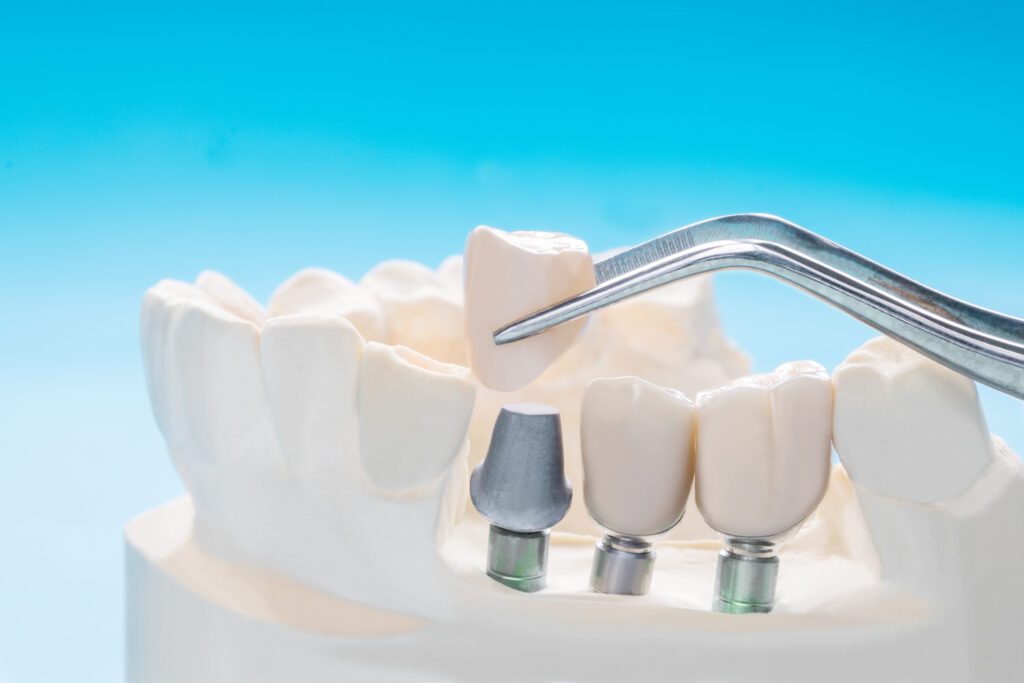Have you just lost a permanent tooth? Do you have multiple missing teeth? Ask us about dental bridge treatment. A dental bridge closes the gap left by one to four teeth. Bridges replace consecutive missing teeth with a durable dental restoration that looks and feels natural. Dental bridges are one of the restorative dentistry services we offer to the public in Clarkston, Michigan.
Our dentists provide dental bridges to patients in Clarkston, MI, so they can receive a restoration that improves the appearance and health of the teeth and gums. In addition, restoring missing teeth prevents shifting and overcrowding of remaining teeth.

Traditional vs. Implant Dental Bridges
A traditional dental bridge is false teeth held in place by crown-capped natural teeth. These natural teeth are on either side of the tooth gap left by missing teeth. While traditional bridges restore the appearance of missing teeth, they do not offer stability. In addition, bridges do not support bone or gum health because they lie on top of the gums.
Dental implants offer a longer-lasting alternative to traditional dental bridges. Rather than relying on natural teeth for support, implants replace teeth at the root. Implant-secured dental bridges create a more natural bite because implants create a stable foundation for replacement teeth.
Dental Bridge Treatment in Clarkston, MI
Before restorative treatments, we ensure that patients are in good oral health. Then, we can provide periodontal therapy, extractions, and other treatments as needed. Additionally, if patients want implants but do not have enough jaw bone tissue to support them, we will recommend bone grafting. Grafting provides patients with healthy gum tissue to support implants.
We will take digital impressions of the teeth and gums to plan the dental bridge and implant treatment. Using these impressions, technicians create a dental bridge that matches the appearance and feel of natural teeth. Meanwhile, we place the implants in the jaw bone to support the bridge. Finally, after three to six months, we place the dental bridge on the healed implants.
How to Clean and Care for a Dental Bridge
As with any dental restoration, the better you care for it, the longer it will last. Preventing plaque buildup will eliminate many dental issues and help to keep your dental bridge and oral health in check. Here are some tips and guidelines for caring for your dental bridge:
Maintain Regular Oral Hygiene
An oral hygiene routine should already be part of your life. However, when you have a dental restoration, it is especially important to maintain its longevity. You must brush your teeth at least twice a day with a soft-bristle toothbrush. Pay extra attention to the areas around the dental bridge to remove plaque and food particles. Also, use dental floss to clean between your teeth. You will need to use a floss threader to clean between the bridge and the adjacent natural teeth. Doing this will remove debris and plaque from hard-to-reach areas.
Specialized Tools
You have option of using special tools including interdental brushes. Interdental brushes, or proxy brushes, will allow you to clean areas around and under the dental bridge. These small brushes can help reach spaces that may be challenging with regular floss.
Use Mouthwash If Your Dentist Suggests It
Rinse your mouth with an antimicrobial or fluoride mouthwash to help reduce bacteria and strengthen teeth. However, consult your dentist before using any specific mouthwash because some may contain ingredients that can damage certain types of dental work.
Visit your Dentist for Regular Dental Check-ups
You should schedule regular dental check-ups and teeth cleanings with your dentist. Your dentist will monitor the condition of your dental bridge, identify any issues early on, and professionally clean hard-to-reach areas.
Avoid Damaging Habits
Avoid biting down on hard or sticky foods that could potentially damage the dental bridge. This includes chewing on ice, eating hard candy, or biting on your finger nails. If you grind your teeth at night (bruxism), consider using a night guard to protect both natural teeth and dental work.
Address Dental Problems Right Away
If you notice any issues with your dental bridge, please contact our dental office as soon as possible. Problems such as looseness, discomfort, or changes in how it fits could mean that it requires an adjustment or that it is damaged. Dr. Sesi will evaluate the dental bridge and make any necessary adjustments suggest other treatments.
Proper Oral Hygiene for Abutment Teeth
If your dental bridge is supported by natural teeth (abutment teeth), it’s crucial to maintain good oral hygiene of those teeth. If those teeth become decayed, it will affect the health and functionality of the entire dental bridge. Follow the same brushing and flossing techniques to keep these teeth healthy.
Contact Our Dental Office
Do you want to restore multiple missing teeth with a dental bridge? Schedule a dental appointment with Dr. Sesi online or call 248-985-2906. Please let our dentists know if you have concerns or questions at your next consultation. They are here to help.
